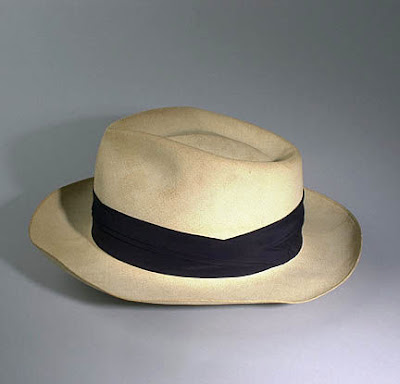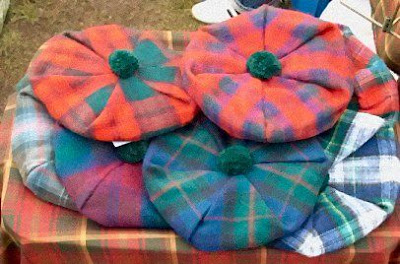One of the first pictorial depictions of a hat appears in a Thebes tomb painting which shows a man wearing a coolie-style straw hat. Other early hats were the Pileus, a simple skull cap; the Phrygian cap, worn by freed slaves in Greece and Rome; and the Greek Pestasos, the first known hat with a brim. Women wore veils, kerchiefs, hoods, caps and wimples. Structured hats for women similar to those of male courtiers began to be worn in the late 16th century. The term ‘milliner’ comes from the Italian city of Milan, where the best quality hats were made in the 18th century. Millinery was traditionally a woman’s occupation, with the milliner not only creating hats and bonnets but also choosing lace, trimmings and accessories to complete an outfit.
 |
| Akubra. Australian felt hat with a wide brim. |
 |
Baseball cap. A type of soft cap with a long, stiffened and curved peak.
|
 |
Beanie. A brimless cap with a small visor once popular among school boys.
|
 |
Biretta. A square cap with three or four ridges or peaks worn by
Roman Catholic clergy and some Anglican and Lutheran clergy.
|
 |
Boonie hat. A soft cotton wide-brim hat commonly used by
militaries. Similar to a bucket hat.
|
 |
Boss of the plains. A lightweight all-weather hat designed by
John B. Stetson for the demands of the American west. |
 |
Bucket hat. A soft cotton hat with a wide, downwards-sloping brim.
|
 |
| Busby. A small fur military hat. |
 |
Capotain. A hat worn from the 1590s through the 1640s in England
and Northwestern Europe. It is also commonly called a Pilgrim hat
|
 |
Caubeen. A British military headdress, also worn in Canadian army.
A pipe band in California wear a headdress with the same name.
|
 |
Chullo. Peruvian or Bolivian hat with ear-flaps made from
vicuña, alpaca, llama or sheep's wool.
|
 |
| Cloche hat. Popular bell-shaped ladies hat of the 1920s. |
 |
| Cordobés. Flat-brimmed and flat-topped traditional hat originating from Córdoba, Spain, associated with Flamenco and popularized by characters such as the fictional Zorro. |
 |
Conical Asian hat. Simple straw hat associated with East and Southeast Asia.
|
 |
Cowboy hat. High-crowned, wide-brimmed hat, with a sweatband on the inside,
and a decorative hat band on the outside. Customized by
creasing the crown and rolling the brim.
|
 |
Custodian helmet. Police helmet worn by
British constables while on foot patrol. |
 |
Deerstalker. Warm close-fitting tweed cap designed for hunting in
the wet and windy Scottish climate, with brims in front and behind,
and ear flaps which can be tied together either over the crown or under the chin;
anachronistically associated with Sherlock Holmes.
|
 |
Dunce cap. A hat that was used to punish and humiliate students in
school during the late 19th and early 20th centuries.
It is shaped like a cone and often has a
big capital 'D' inscribed on the front.
|
 |
Fascinator. A small hat commonly made with feathers,
flowers and/or beads. It attaches to the hair by a comb, headband or clip. |
 |
Fedora. A soft felt hat with a lengthwise crease.
|
 |
Flat cap. A soft, round men's cap with a small brim in front.
|
 |
Garrison or Forage cap. A foldable cloth cap with straight sides
and a creased or hollow crown.
|
 |
Ghutrah. Three piece ensemble consisting of a Thagiyah skull cap, Gutrah scarf,
and Ogal black band. Gutrahs are plain white or checkered,
denoting ethnic or national identities. |
 |
Hard hat. A helmet predominantly used in workplace environments,
such as construction sites, to protect the head from injury by falling objects,
debris and bad weather. |
 |
Homburg. A semi-formal hat with a crease and no dents.
|
 |
Kepi. A French military hat with a flat, circular top and visor.
|
 |
| Kova tembel. Cloth hat worn by Israeli pioneers and kibbutzniks. |
 |
Montera. A crocheted hat worn by bullfighters.
|
 |
Mortarboard. Flat, square hat with a tassel worn as
part of academic dress.
|
 |
Panama. Straw hat made in Ecuador.
|
 |
Peaked cap. A military style cap with a crown, band and peak (also called a visor).
It is used by many militaries of the world as well as law enforcement,
as well as some people in service professions who wear uniforms. |
 |
Pith Helmet. A lightweight cloth-covered helmet made of cork or pith.
|
 |
Porkpie. Circular, flat topped hat.
|
 |
Santa Hat. A floppy pointed red hat trimmed in white fur traditionally
associated with Christmas.
|
 |
Shako. A tall cylindrical military cap, usually with a visor,
badge, and plume.
|
 |
Shtreimel. A fur hat worn by married Hassidic men
on Shabbat and holidays. |
 |
Slouch. Generic term covering wide-brimmed felt-crowned hats like
those worn by the military and ranchers.
|
 |
Sombrero. A Mexican hat with a conical crown and a saucer-shaped brim,
highly embroidered made of plush felt.
|
 |
Student cap A cap worn by university students in
various European countries.
|
 |
Tam o' Shanter. A Scottish wool hat originally worn by men.
|
 |
Top hat. A tall, flat-crowned, cylindrical hat worn by men in the 19th and
early 20th centuries, now worn only with morning dress or evening dress.
Also known as a stovepipe hat.
|
 |
| Toque. A tall, pleated, brimless, cylindrical hat traditionally worn by chefs. |
 |
Trilby. A soft felt men's hat with a deeply indented crown and
a narrow brim often upturned at the back.
|
 |
Trucker hat. Similar to a baseball cap, usually with a foam brim and
front section and a breathable mesh back section. |
 |
Tuque. A knitted hat, worn in winter, usually made from wool or acrylic.
Also known as a ski cap, knit hat, knit cap, sock cap, stocking cap,
toboggan, watch cap, or goobalini. |
 |
Tyrolean hat. A felt hat originating from the Alps.
|
 |
| A collection of 18th and 19th century hats |
 |
Bearskin. The tall, furry, full dress uniform hat of the Brigade of Guards
designed to protect the footguards against sword-cuts,
commonly seen at Buckingham Palace.
|
 |
Bicorne. Military hat with upturned corners, also known as a cocked hat.
|
 |
Barretina. A traditional style, in red it is now used as
a symbol of Catalan identity. It is worn with the top flopping down. |
 |
Chupalla. Straw hat made in Chile.
|
 |
Boater. Flat-brimmed and flat-topped straw hat, formerly worn by seamen,
and now mostly at summer regattas or garden parties,
often with a ribbon in club or college colors.
|
 |
| Taqiyah. A round fabric cap worn by Muslim men. |
 |
Kolpik. Brown fur hat worn by Hassidic Jews.
|
 |
Phrygian Cap. A soft conical cap pulled forward. In sculpture, paintings
and caricatures it represents freedom and the pursuit of liberty.
The popular comic / cartoon characters The Smurfs, are famous for
their white Phrygian caps. Their leader, Papa Smurf wears a red one.
|
 |
Beret. Soft round cap, usually of wool felt, with a flat crown,
worn by both men and women and traditionally associated with France.
Also used in the military. |
 |
Bowler / Derby. A hard felt hat with a rounded crown created in
1850 by Lock's of St James's, the hatters to Thomas Coke, 2nd Earl of Leicester,
for his servants. Sometimes known as a derby hat. |
 |
Ushanka. Russian fur hat with fold down ear flaps.
|
 |
Sami hat. Also known as a "Four Winds" hat, traditional men's hat
of the Sami people.
|
 |
Gatsby. A soft brimmed hat popular in New York after the turn of the
century made from eight quarter panels. Also known as a newsboy cap. |
 |
Turban. A headdress consisting of a scarf-like single piece of
cloth wound around either the head itself or an inner hat. |
 |
Fez. Red felt hat in the shape of a truncated cone.
|
 |
Gaung Paung. Headwrap worn by the Bamar, Mon people,
Rakhine and Shan peoples.
|
 |
Hardee hat. Also known as the 1858 Dress Hat. Regulation
hat for Union soldiers during the American Civil War. |
 |
Tudor bonnet. A soft round black academic cap, with a tassel
hanging from acord attached to the centre of the top of the hat. |
 |
Beaver hat. Hats made of felted beaver fur.
|
 |
Balmoral bonnet Traditional Scottish bonnet or
cap worn with Scottish Highland dress. |
 |
| Balaclava. A form of headgear covering the whole head, exposing only the face or upper part of it, and sometimes only the eyes. Also known as a ski mask. |
 |
| Casquette. A small-peaked cap often worn by cyclists. |
 |
Kippah or Yarmulke. A small close-fitting skullcap worn
by religious Jews. |
 |
Pakul. Round, rolled wool hat with a flat top, associated
with Afghanistan and the Mujahideen. |
 |
| Salakot. A traditional hat in the Philippines. |
 |
| Zucchetto. Skullcap worn by clerics. |
 |
Vueltiao. A Colombian hat of woven and sewn black and
khaki dried palm braids with indigenous figures. |
 |
Tricorne. A soft hat with a broad brim, pinned up on either side of the
head and at the back, producing a triangular shape. |














































































 //PART 2
//PART 2
No comments:
Post a Comment